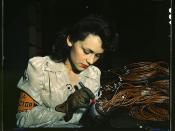The Women's Movement brought about many changes for women in the period from 1945 to the 1980s. Women used many methods like writing books, distributing pamphlets, protesting and striking, which will be discussed in this essay, to make a point to the government. Women in Australia wanted changes made to certain things such as equal pay for equal work, they wanted to change society's view of the typical women, and they generally wanted their rights changed and improved. This essay will discuss why women felt the need to do these radical things and why they wanted change. This essay will also deal with the methods they used and the outcomes of this movement, suffragists, such as author Germaine Greer, the slow road to achieving success and how the attitude and role of women in society changed as a result of the feminist movement.
Australian women have long played a crucial role in the development of our nation.
The women pioneers of our nation lived through incredibly tough times, and worked alongside their husbands, to build a new life for themselves, and their families, out of virtually nothing.
The Women's Liberation Movement was the second wave of feminist activism. The first was in the late nineteenth century when women campaigned for the right to vote. Second wave feminists campaigned for equal pay and equal opportunities, child welfare, divorce laws and anti-discrimination legislation. Women also demanded freedom of choice in education, employment, marriage, contraception and the right to abortion. Their concerns included; women were not receiving equal pay as for the same work as men and women were not able to make decisions concerning their personal lives. Anti-discrimination laws were passed to protect the rights of women in the 1970's, and women also achieved equal legal status in the workforce.
The Women's Liberation Movement had one main goal, and that was to gain equality for women, in both the home, and the workplace. Women attempted to reach their goal through a variety of methods. One method was consciousness-raising, (raising people awareness of an issue or problem) through re-education of women concerning their rights, or lack thereof. The most important and effective tactic of the movement was political lobbying. The Women's Electoral Lobby, set up in 1972, placed pressure on unions and politicians. Pressure on politicians, unions and the government led to the establishment of things the benefited women such as; rape crisis centers, childcare facilities, women's refuges, family planning clinics, and health centers for both women and their children. Pressure was also placed on the ACTU to grant women equal pay for equal work. Attempts to gain equal pay before 1972, led to a decision that women would only receive equal pay if they could prove they were doing the same amount of work as men. These methods were successful and many gains were made in changing employment for women, giving women a say in their personal lives and allowing women to take part in decision-making bodies which would effect Australia's future.
Before WWII, Australian women had well-defined roles. The single women was expected to find employment in a female occupation whilst awaiting marriage, her true 'calling' in life. Women were to be nurturing mothers, cooks, cleaners, and diligently minister to her husbands need, so that he could function without distraction from the outside world. She was judged on the success of her husband, the good behaviour of her children and the cleanliness of her home.
The Second World War took women out of the home and placed them in the workforce, to take the place of men. This gave women a sense of value and achievement and provided them with a broader outlook on life. This experience was taken away from women once the men returned home from the war to their jobs and women were forced back into the home, to "populate or perish". There was a renewed push for women to be dedicated to motherhood and the home for the overall well-being of the nation.
During the Second World War, women proved that they were capable of doing factory work, however, they did not receive the same pay as males. In the 1950's, women were struggling to receive 75% of the male wage. This is one of the factors that triggered the movement. With the change in the Australian economy after the war, Australia needed labour. This was made obvious by the extent of immigration that was encouraged by the governments. Although, immigration did not solve the problem. In the areas of textiles, clothing manufacturing, and mass production lines, women were exploited as cheap labour.
One prominent feminist figure throughout the feminist movement was Australian author Germaine Greer. Debates over women's rights were fuelled by Greer's book "The Female Eunuch", a novel about the role of women as slaves to men. The vulgar language and astonishing points brought up in this novel shocked Australian's and made women reconsider their roles in society. She believed that women had been taught to put the needs of their husbands and children before their own, and she did not agree with this. She wrote that women were just as capable of creativity and higher thought as men. Ms Greer wrote things that changed women view of society, such as
⦠why should a women serve a man so faithfully for a menial's wage and be actually increasing his earning power and cloaking his mistakes? Seeing as she knows business pretty well, why should she not aspire to his job?
(Greer, 1971:125)
Throughout the 1950's and 1960's more women than men entered the workforce in Australia. This was in part a reflection of the need for a second income in the family and also an expression of women's right to escape from the daily routine of their suburban lives, which entrapped women of earlier generations. Women worked in what was referred to as "women's work", like teaching, nursing, hairdressing or secretarial work, or they had been forced into the hard unskilled factory work, due to their economic need. The 'women's' occupations were often paid about a third lower than male occupations, although they produced the same amount of work. As Germaine Greer wrote, in "The Female Eunuch",
⦠it is assumed that wives earn less than their husbands, and pity is evinced for men whose wives are more successful than they are.
(Greer, 1971:123)
By the 1960's the movement challenged women to re-define themselves by their own needs, and not of the needs of their families. The main push of the of the Women's Liberation Movement was self-education and self-expression. This new self-expression included freedom from the traditional roles of women. It attacked forces that wanted to put women back in the home and by 1970, many women broke away from the churches' moral views concerning issues like sex before marriage, contraception, the sanctity of marriage and male authority.
By educating Australians about the sexism of language and forcing people to take notice of issues concerning females in the workplace, they were able to achieve change. If thoughts and attitudes could not be changed, then at lest actions could.
In conclusion, the methods women used to achieve change during Women's Liberation Movement were incredibly effective. Although it was a slow road to success, women received better pay in some professions, better conditions for female workers, health and safety for women workers, maternity leave and childcare available for working mothers. Many centres were also established for women with problems, to allow help to be given to them and/or their families. Although women are still fighting for many changes in the workforce, society's view of women, and many other things, the Women's Liberation Movement made significant changes to women's rights and roles in Australia in the period from 1945 to the 1980's. Women should always fight for what they believe or feel is right, and, in the words of feminist Susan Alice Watkins;
If women never let themselves go, how will they ever know how far they may have got?
(Watkins, 1992:63)


